Abhinav Dhall
Indian Institute of Technology Ropar
A Survey of Body and Face Motion: Datasets, Performance Evaluation Metrics and Generative Techniques
Dec 09, 2025Abstract:Body and face motion play an integral role in communication. They convey crucial information on the participants. Advances in generative modeling and multi-modal learning have enabled motion generation from signals such as speech, conversational context and visual cues. However, generating expressive and coherent face and body dynamics remains challenging due to the complex interplay of verbal / non-verbal cues and individual personality traits. This survey reviews body and face motion generation, covering core concepts, representations techniques, generative approaches, datasets and evaluation metrics. We highlight future directions to enhance the realism, coherence and expressiveness of avatars in dyadic settings. To the best of our knowledge, this work is the first comprehensive review to cover both body and face motion. Detailed resources are listed on https://lownish23csz0010.github.io/mogen/.
CSGaze: Context-aware Social Gaze Prediction
Nov 14, 2025Abstract:A person's gaze offers valuable insights into their focus of attention, level of social engagement, and confidence. In this work, we investigate how contextual cues combined with visual scene and facial information can be effectively utilized to predict and interpret social gaze patterns during conversational interactions. We introduce CSGaze, a context aware multimodal approach that leverages facial, scene information as complementary inputs to enhance social gaze pattern prediction from multi-person images. The model also incorporates a fine-grained attention mechanism centered on the principal speaker, which helps in better modeling social gaze dynamics. Experimental results show that CSGaze performs competitively with state-of-the-art methods on GP-Static, UCO-LAEO and AVA-LAEO. Our findings highlight the role of contextual cues in improving social gaze prediction. Additionally, we provide initial explainability through generated attention scores, offering insights into the model's decision-making process. We also demonstrate our model's generalizability by testing our model on open set datasets that demonstrating its robustness across diverse scenarios.
A Multi-Modal Neuro-Symbolic Approach for Spatial Reasoning-Based Visual Grounding in Robotics
Oct 30, 2025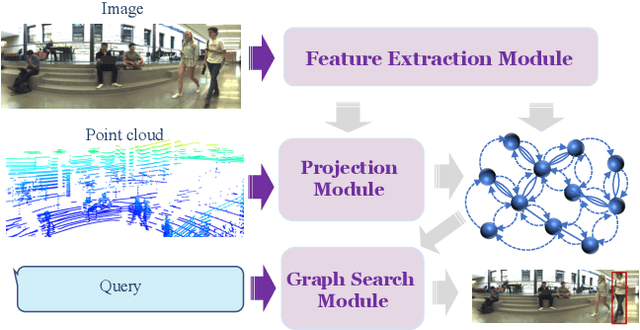
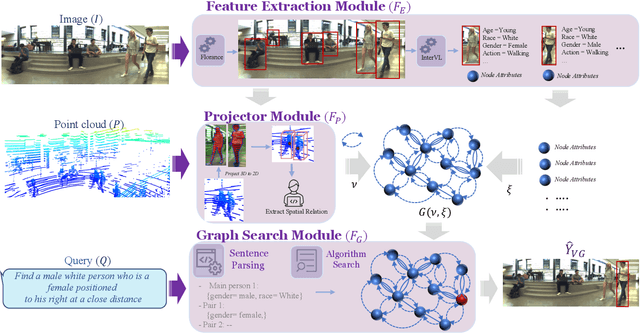
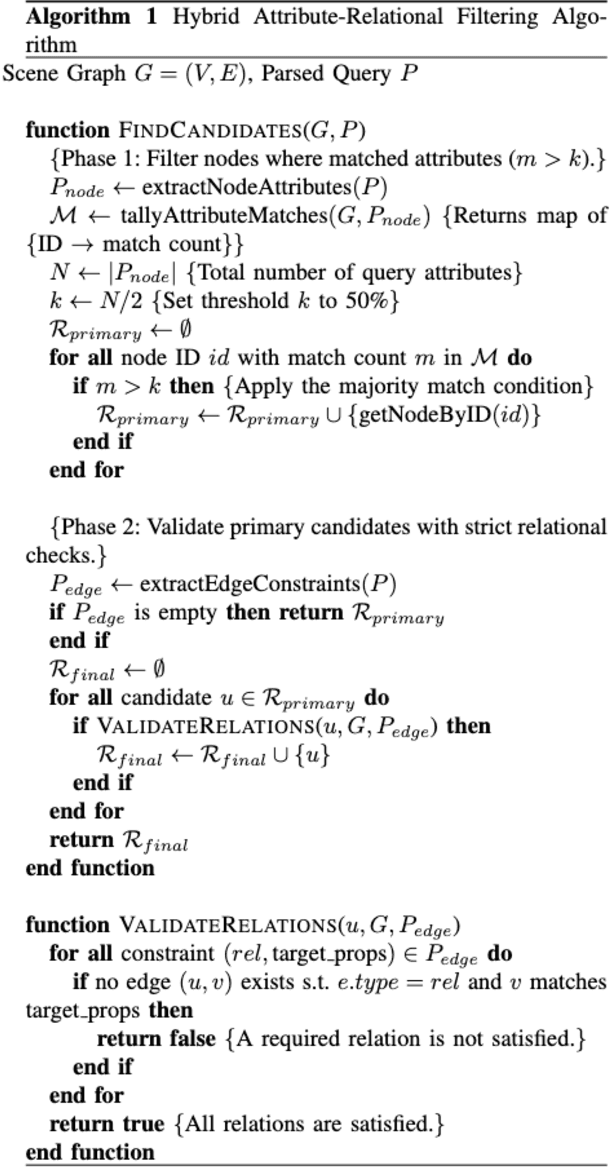
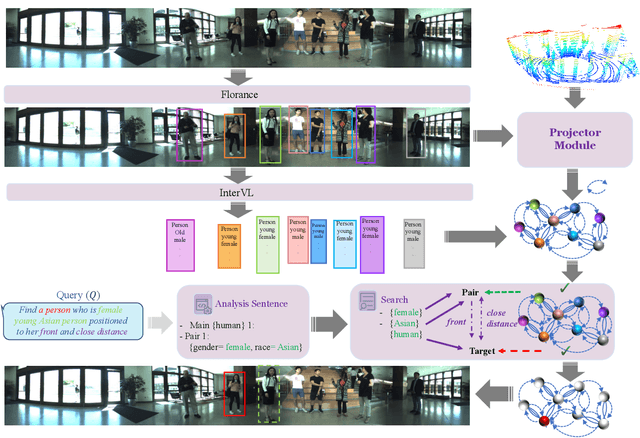
Abstract:Visual reasoning, particularly spatial reasoning, is a challenging cognitive task that requires understanding object relationships and their interactions within complex environments, especially in robotics domain. Existing vision_language models (VLMs) excel at perception tasks but struggle with fine-grained spatial reasoning due to their implicit, correlation-driven reasoning and reliance solely on images. We propose a novel neuro_symbolic framework that integrates both panoramic-image and 3D point cloud information, combining neural perception with symbolic reasoning to explicitly model spatial and logical relationships. Our framework consists of a perception module for detecting entities and extracting attributes, and a reasoning module that constructs a structured scene graph to support precise, interpretable queries. Evaluated on the JRDB-Reasoning dataset, our approach demonstrates superior performance and reliability in crowded, human_built environments while maintaining a lightweight design suitable for robotics and embodied AI applications.
Gems: Group Emotion Profiling Through Multimodal Situational Understanding
Jul 30, 2025Abstract:Understanding individual, group and event level emotions along with contextual information is crucial for analyzing a multi-person social situation. To achieve this, we frame emotion comprehension as the task of predicting fine-grained individual emotion to coarse grained group and event level emotion. We introduce GEMS that leverages a multimodal swin-transformer and S3Attention based architecture, which processes an input scene, group members, and context information to generate joint predictions. Existing multi-person emotion related benchmarks mainly focus on atomic interactions primarily based on emotion perception over time and group level. To this end, we extend and propose VGAF-GEMS to provide more fine grained and holistic analysis on top of existing group level annotation of VGAF dataset. GEMS aims to predict basic discrete and continuous emotions (including valence and arousal) as well as individual, group and event level perceived emotions. Our benchmarking effort links individual, group and situational emotional responses holistically. The quantitative and qualitative comparisons with adapted state-of-the-art models demonstrate the effectiveness of GEMS framework on VGAF-GEMS benchmarking. We believe that it will pave the way of further research. The code and data is available at: https://github.com/katariaak579/GEMS
AV-Deepfake1M++: A Large-Scale Audio-Visual Deepfake Benchmark with Real-World Perturbations
Jul 28, 2025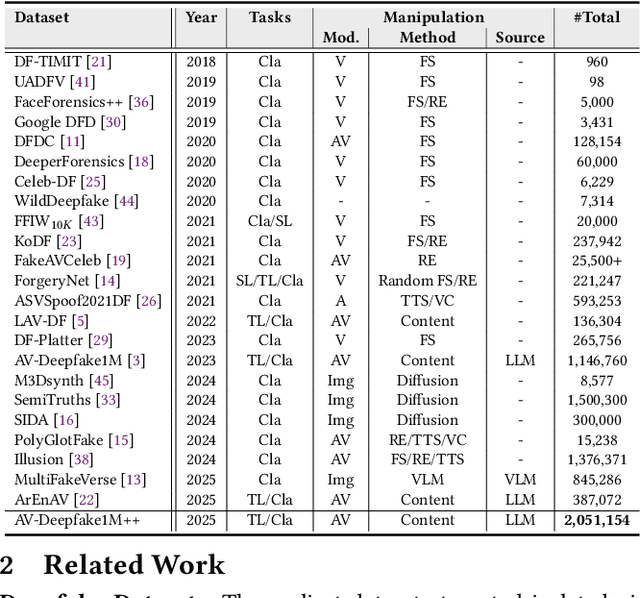
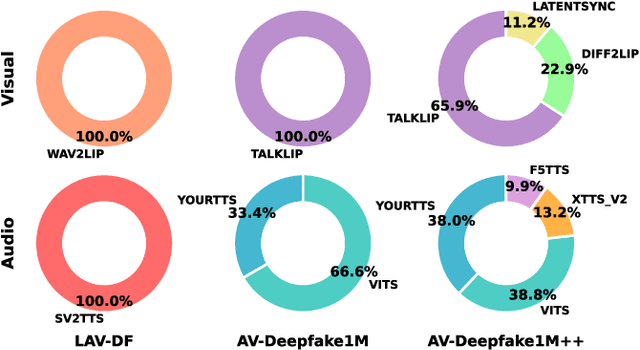
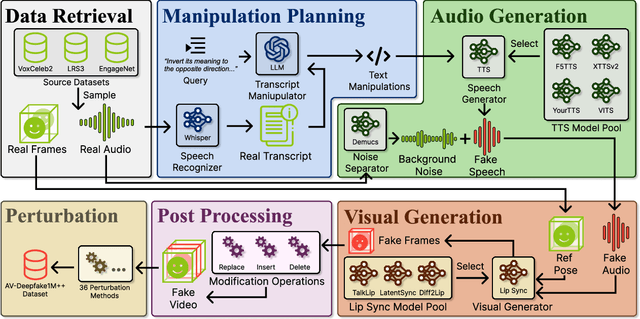
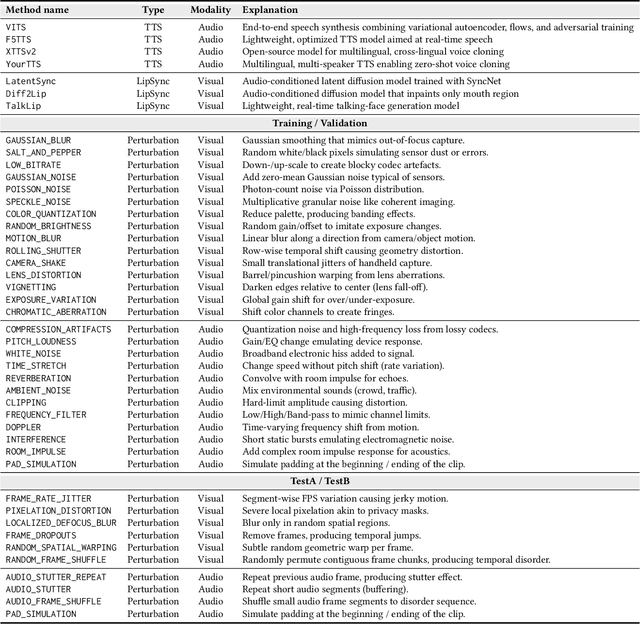
Abstract:The rapid surge of text-to-speech and face-voice reenactment models makes video fabrication easier and highly realistic. To encounter this problem, we require datasets that rich in type of generation methods and perturbation strategy which is usually common for online videos. To this end, we propose AV-Deepfake1M++, an extension of the AV-Deepfake1M having 2 million video clips with diversified manipulation strategy and audio-visual perturbation. This paper includes the description of data generation strategies along with benchmarking of AV-Deepfake1M++ using state-of-the-art methods. We believe that this dataset will play a pivotal role in facilitating research in Deepfake domain. Based on this dataset, we host the 2025 1M-Deepfakes Detection Challenge. The challenge details, dataset and evaluation scripts are available online under a research-only license at https://deepfakes1m.github.io/2025.
Tell me Habibi, is it Real or Fake?
May 28, 2025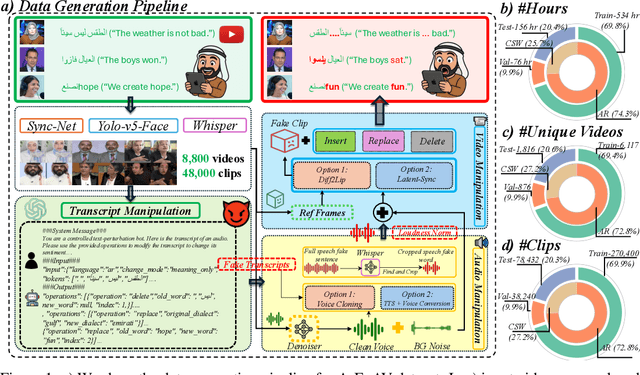



Abstract:Deepfake generation methods are evolving fast, making fake media harder to detect and raising serious societal concerns. Most deepfake detection and dataset creation research focuses on monolingual content, often overlooking the challenges of multilingual and code-switched speech, where multiple languages are mixed within the same discourse. Code-switching, especially between Arabic and English, is common in the Arab world and is widely used in digital communication. This linguistic mixing poses extra challenges for deepfake detection, as it can confuse models trained mostly on monolingual data. To address this, we introduce \textbf{ArEnAV}, the first large-scale Arabic-English audio-visual deepfake dataset featuring intra-utterance code-switching, dialectal variation, and monolingual Arabic content. It \textbf{contains 387k videos and over 765 hours of real and fake videos}. Our dataset is generated using a novel pipeline integrating four Text-To-Speech and two lip-sync models, enabling comprehensive analysis of multilingual multimodal deepfake detection. We benchmark our dataset against existing monolingual and multilingual datasets, state-of-the-art deepfake detection models, and a human evaluation, highlighting its potential to advance deepfake research. The dataset can be accessed \href{https://huggingface.co/datasets/kartik060702/ArEnAV-Full}{here}.
MAVEN: Multi-modal Attention for Valence-Arousal Emotion Network
Mar 16, 2025Abstract:This paper introduces MAVEN (Multi-modal Attention for Valence-Arousal Emotion Network), a novel architecture for dynamic emotion recognition through dimensional modeling of affect. The model uniquely integrates visual, audio, and textual modalities via a bi-directional cross-modal attention mechanism with six distinct attention pathways, enabling comprehensive interactions between all modality pairs. Our proposed approach employs modality-specific encoders to extract rich feature representations from synchronized video frames, audio segments, and transcripts. The architecture's novelty lies in its cross-modal enhancement strategy, where each modality representation is refined through weighted attention from other modalities, followed by self-attention refinement through modality-specific encoders. Rather than directly predicting valence-arousal values, MAVEN predicts emotions in a polar coordinate form, aligning with psychological models of the emotion circumplex. Experimental evaluation on the Aff-Wild2 dataset demonstrates the effectiveness of our approach, with performance measured using Concordance Correlation Coefficient (CCC). The multi-stage architecture demonstrates superior ability to capture the complex, nuanced nature of emotional expressions in conversational videos, advancing the state-of-the-art (SOTA) in continuous emotion recognition in-the-wild. Code can be found at: https://github.com/Vrushank-Ahire/MAVEN_8th_ABAW.
MRAC Track 1: 2nd Workshop on Multimodal, Generative and Responsible Affective Computing
Sep 11, 2024Abstract:With the rapid advancements in multimodal generative technology, Affective Computing research has provoked discussion about the potential consequences of AI systems equipped with emotional intelligence. Affective Computing involves the design, evaluation, and implementation of Emotion AI and related technologies aimed at improving people's lives. Designing a computational model in affective computing requires vast amounts of multimodal data, including RGB images, video, audio, text, and physiological signals. Moreover, Affective Computing research is deeply engaged with ethical considerations at various stages-from training emotionally intelligent models on large-scale human data to deploying these models in specific applications. Fundamentally, the development of any AI system must prioritize its impact on humans, aiming to augment and enhance human abilities rather than replace them, while drawing inspiration from human intelligence in a safe and responsible manner. The MRAC 2024 Track 1 workshop seeks to extend these principles from controlled, small-scale lab environments to real-world, large-scale contexts, emphasizing responsible development. The workshop also aims to highlight the potential implications of generative technology, along with the ethical consequences of its use, to researchers and industry professionals. To the best of our knowledge, this is the first workshop series to comprehensively address the full spectrum of multimodal, generative affective computing from a responsible AI perspective, and this is the second iteration of this workshop. Webpage: https://react-ws.github.io/2024/
1M-Deepfakes Detection Challenge
Sep 11, 2024



Abstract:The detection and localization of deepfake content, particularly when small fake segments are seamlessly mixed with real videos, remains a significant challenge in the field of digital media security. Based on the recently released AV-Deepfake1M dataset, which contains more than 1 million manipulated videos across more than 2,000 subjects, we introduce the 1M-Deepfakes Detection Challenge. This challenge is designed to engage the research community in developing advanced methods for detecting and localizing deepfake manipulations within the large-scale high-realistic audio-visual dataset. The participants can access the AV-Deepfake1M dataset and are required to submit their inference results for evaluation across the metrics for detection or localization tasks. The methodologies developed through the challenge will contribute to the development of next-generation deepfake detection and localization systems. Evaluation scripts, baseline models, and accompanying code will be available on https://github.com/ControlNet/AV-Deepfake1M.
MIP-GAF: A MLLM-annotated Benchmark for Most Important Person Localization and Group Context Understanding
Sep 10, 2024Abstract:Estimating the Most Important Person (MIP) in any social event setup is a challenging problem mainly due to contextual complexity and scarcity of labeled data. Moreover, the causality aspects of MIP estimation are quite subjective and diverse. To this end, we aim to address the problem by annotating a large-scale `in-the-wild' dataset for identifying human perceptions about the `Most Important Person (MIP)' in an image. The paper provides a thorough description of our proposed Multimodal Large Language Model (MLLM) based data annotation strategy, and a thorough data quality analysis. Further, we perform a comprehensive benchmarking of the proposed dataset utilizing state-of-the-art MIP localization methods, indicating a significant drop in performance compared to existing datasets. The performance drop shows that the existing MIP localization algorithms must be more robust with respect to `in-the-wild' situations. We believe the proposed dataset will play a vital role in building the next-generation social situation understanding methods. The code and data is available at https://github.com/surbhimadan92/MIP-GAF.
 Add to Chrome
Add to Chrome Add to Firefox
Add to Firefox Add to Edge
Add to Edge